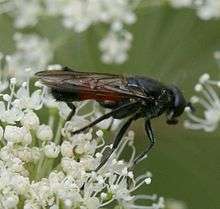Brachypalpoides lentus
Brachypalpoides lentus is a European species of hoverflies.[1]
| Brachypalpoides lentus | |
|---|---|
 | |
| Scientific classification | |
| Kingdom: | |
| Phylum: | |
| Class: | |
| Order: | |
| Family: | |
| Subfamily: | |
| Tribe: | |
| Genus: | |
| Species: | B. lentus |
| Binomial name | |
| Brachypalpoides lentus Meigen, 1822 | |
Description
External images Wing length 10–12 mm. The legs are black; tergites 2 and 3, and base of tergite 4 in female, red. Tip of abdomen black. Mimics sawflies.[2] [3] [4][5] The larva is not described but is included in keys in It is illustrated by Rotheray (1993)[6]
Distribution
Scandinavia South to the Pyrenees and central Spain. Ireland East through central Europe into European parts of Russia; southern Europe East to Yugoslavia and Greece and into Asia Minor.[7][8]
Habitat
A forest species associated with mature trees of Fagus, Picea and Quercus and including evergreen oak forest.[9]
Biology
Runs on foliage of bushes of Rubus fruticosus at the edge of forest clearings and on the ground near fallen or felled trees. Flowers visited include umbellifers, Galium, Crataegus, Rubus idaeus, Sorbus aucuparia.[10] Flight period is April to June (and July at higher altitudes).
References
- Stubbs, Alan E. & Falk, Steven J. (1983). British Hoverflies: An Illustrated Identification Guide. British Entomological & Natural History Society. pp. 253, xvpp.
- Van Veen, M. (2004) Hoverflies of Northwest Europe: identification keys to the Syrphidae. 256pp. KNNV Publishing, Utrecht.
- Van der Goot,V.S. (1981) De zweefvliegen van Noordwest - Europa en Europees Rusland, in het bijzonder van de Benelux. KNNV, Uitgave no.32: 275pp. Amsterdam.
- Bei-Bienko, G.Y. & Steyskal, G.C. (1988) Keys to the Insects of the European Part of the USSR, Volume V: Diptera and Siphonaptera, Part I. Amerind Publishing Co., New Delhi. ISBN 81-205-0080-6.
- Coe, R.L. (1953) Diptera: Syrphidae. Handbks.ident.Br.insects, 10(1): 1-98. R.ent.Soc.London. pdf
- Rotheray G., 1993 Colour Guide to Hoverfly Larvae Diptera, Syrphidae in Britain and Europe Dipterists Forum pdf Archived 2019-04-03 at the Wayback Machine
- Fauna Europaea
- Peck, L.V. (1988) Syrphidae. In: Soos, A. & Papp, L. (eds.) Catalogue of Palaearctic Diptera, 8: 11-230. Akad.Kiado, Budapest.
- Speight, M.C.D. (2011). "Species accounts of European Syrphidae (Diptera)" (PDF). Syrph the Net, the database of European Syrphidae. 65: 285pp.
- de Buck, N. (1990) Bloembezoek en bestuivingsecologie van Zweefvliegen (Diptera, Syrphidae) in het bijzonder voor België. Doc.Trav. IRSNB, no.60, 1-167.